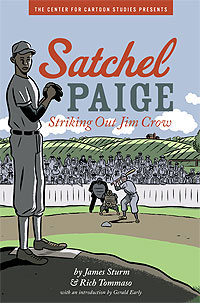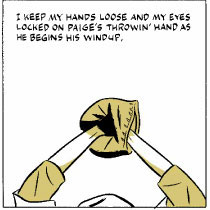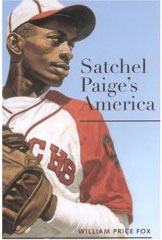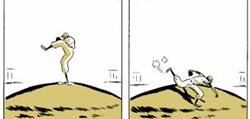Satchel Paige: Striking Out Jim Crow
By Beth Davies-Stofka
April 13, 2008 - 10:53
Jump at the Sun/Hyperion
Writer(s): James Sturm
Penciller(s): Rich Tommaso
ISBN: 978-0786839018
$9.99, 90 p, 2008
 |
The back cover of Satchel Paige contains wickedly false advertising, telling the potential reader that the book "follows Paige from his earliest days on the mound through the pinnacle of his career." This book is not a biography of Satchel Paige at all. It is a story of an unnamed black sharecropper who has a very short stint in the Negro Leagues. Paige's pitching has dramatic effect in this sharecropper's life, once in 1929, and again in 1944.
At the start of this novel, it is 1929, and an eighteen year-old husband and father leaves his sharecropping shack in Tuckwilla, Alabama to earn a much higher wage playing for the Memphis Red Sox, an organization in the Negro League. In a match-up against the famous Satchel Paige, he sustains a career-ending injury, and goes back home to cultivate cotton. Years of back-breaking work, suffering at the hands of privileged whites, take their toll on him. He keeps his anger bottled up inside.
Through a terse first-person narrative, Sturm reveals, in clear, simple terms, the system of white supremacy and the effect it can have on a man's heart. He shows how whites sustained their privileges through intimidation, humiliation, and violence. He shows how blacks compromised or submitted, to avoid further violence. Without preaching, and without moralizing, this novel dramatically illustrates the crimes of Jim Crow.
 |
On the field of play, the white supremacists of Tuckwilla verbally assault Paige with racist slurs and threats of violence, but Paige is so good, his fastball so fast, that he humiliates them. Their humiliation is so complete that the outcome of the game doesn't matter. We don't bother to check in and see how the whites react. We don't even care who wins the game. This story is not about the whites. It is the story of a black sharecropper and his son that matters. It is the story of the turning of the tide, the awakening of a heart, to what a man is, and what he can be.
I love this book because it is about the hope that an oppressed people needs if they are going to end their oppression. It is about how they find that hope within themselves. It is about what it takes to stand up to the violence that oppresses you and demand justice in the face of lynching, and terrifying night-time attacks on your children. It is about how people who live at the cruel end of institutionalized and systematic racism find their power. That is not an easy story to tell, and it is particularly hard to communicate to children, who are often too innocent to comprehend the cruelty of adults, much less the courage required to stand up to it. Sturm and Tommaso do this the right way. They don't tell the reader. They show it.
 |
| Satchel Paige's America, by William Price Fox |
While it is clear that Paige was astoundingly charismatic, he was also intentionally mercurial, and no audio or video tape exists that would allow us to experience that magnetic quality of his that drew people to him. So why not show him as the stuff of legend? This story suggests Paige's most elusive qualities, showing why he was one of the most beloved athletes in American history. It is a much better approach to acquainting children with the great Satchel Paige than a straightforward biography of the kind promised by the book's back cover.
 |
| Photo from the National Baseball Hall of Fame and Museum. |
 |
And while Paige was a hero to many, above every consideration Paige was a pitcher with revelatory skill. Tommaso doesn't capture that either. In Satchel Paige's America, William Price Fox wrote about looking at a sequence of eight photographs of Paige pitching, laid out side by side:
"What was surprising – why surprising I don't know – was his incredible hip rotation and high leg action and the enormous, seamless arcs of his arms. What was fascinating was the concentration and command in the set of his jaw and in his bright and glistening eyes. But what was so perfect – it was almost beatific – was in the last shot, after a strike had been called, and he was leaning in with both hands on his knees with nothing less than a pure and seismic satisfaction and pleasure shining in his face." (Fox 2005, 129-130)
 |
Still, the story is too amazing to be undermined by several disappointing aesthetic decisions. Make sure your children read this, provided they are over the age of 10. But make sure you read it with them. They need to know this central part of American history, and they need to understand how this history belongs to them, as instruction, challenge, and responsibility.
You will have to help them. In a baffling omission, the annotated footnotes (called "panel discussions") never mention the relationship between the desegregation of Major League Baseball and the Civil Rights Movement. As a result, you will need to do some research in order to talk to your kids, and enrich their experience of this novel.
Recommended for further reading:
Chancellor, John, Ken Burns, Lynn Novick, and Geoffrey C. Ward. 1994. Baseball. [Alexandria, Va.]: PBS Home Video. See especially the second part of Inning Six: The National Pastime 1940-1950.
Frystak, Timothy D. 2007. Jackie Robinson: With Profiles of Satchel Paige and Branch Rickey. Biographical connections. Chicago: World Book.
King, Casey, Linda Barrett Osborne, and Joe Brooks. 1997. Oh, Freedom!: Kids Talk About the Civil Rights Movement with the People Who Made It Happen. New York: A.A. Knopf.
Works Cited:
Fox, William Price. 2005. Satchel Paige's America. Tuscaloosa: University of Alabama Press.
Related Articles:
Fantagraphics Bookstore Has Peter Bagge and James Sturm
